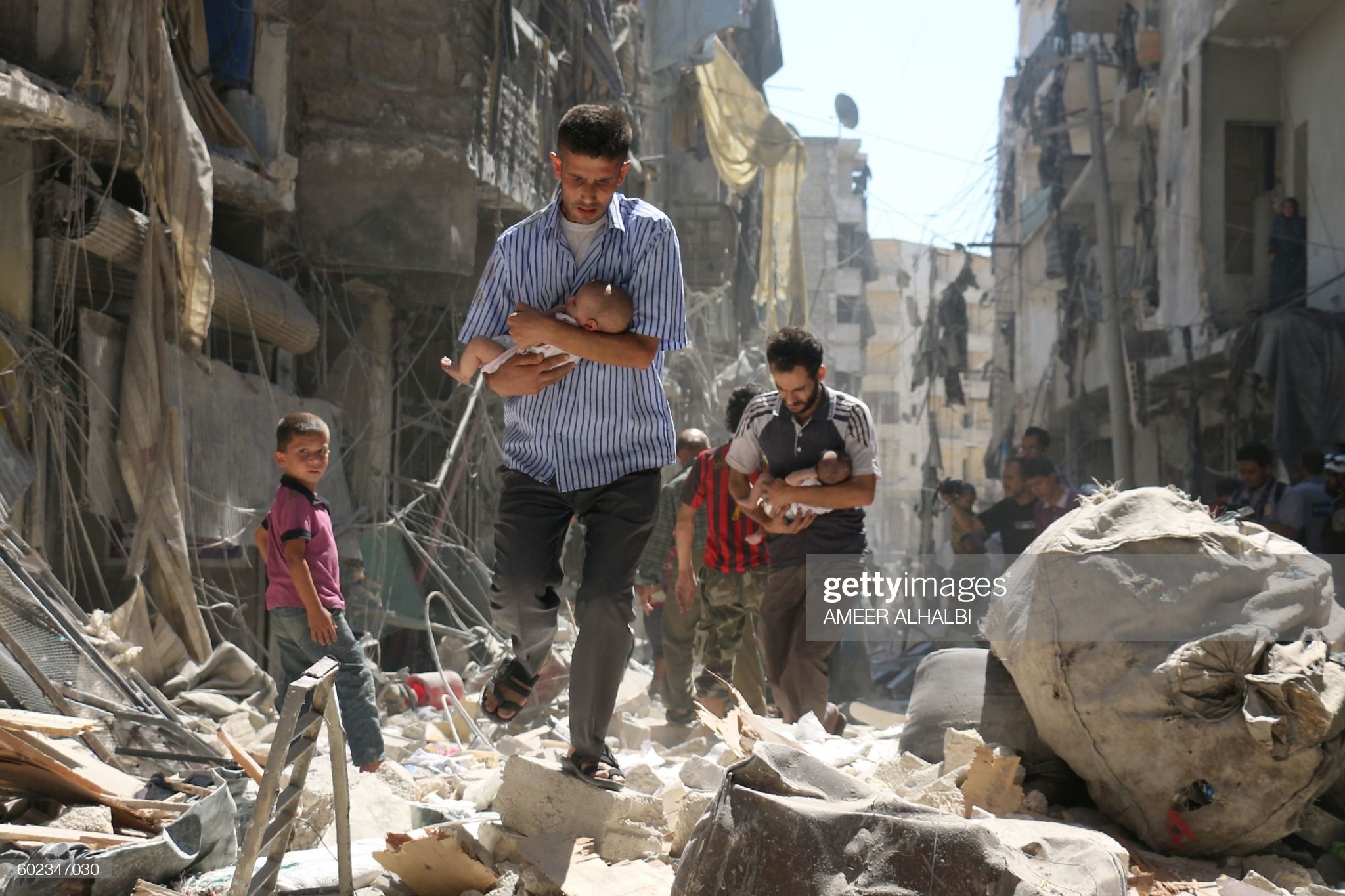Rebuilding Syria: Who will Help?
Topshot - Syria conflict
Source: gettyimages. https://www.gettyimages.com/detail/news-photo/syrian-men-carrying-babies-make-their-way-through-the-news-photo/602347030?adppopup=true
It has been eleven years since the uprising against the president of Syria turned into a full-scale civil war. The war in Syria has led to millions of people experiencing food security, poverty, and terrorism, and being internally displaced within the country’s borders and externally into other parts of the Middle East and Europe.
1. Five major issues in Syria
On June 30, the United Nations Office for the Coordination of Humanitarian Affairs published the 2021 Annual Report for the Syria Humanitarian Fund (SHF). The SHF was initiated in June 2014 and designed to support and bring essential life-saving assistance to Syrian families and communities. In 2021, about 13.4 million people in Syria - that is 2.3 million more than the number of people in need in 2020 - suffered from “a complex and deepening socio-economic crisis, the knock-on effects of COVID-19, and major losses in food production (high cost of agriculture inputs, including fuel, reduced access to water, climate change, and other production-related shocks)”. Although the SHF has allocated about $66.2 million to 113 projects including $34.4 million for life-saving humanitarian assistance to the most vulnerable people, $7.9 million for supporting the protective environment, and $23.9 million for improving access to livelihood opportunities and basic services, there are five major issues we should focus on.
First, influenced by financial distress and price fluctuations, the food security and malnutrition crisis worsened in 2021. In cooperation with the Adventist Development and Relief Agency (ADRA) - an international NGO, the SHF initiated the Food and Livelihood Assistance for Syrian Households project to provide monthly food vouchers - that is equivalent to USD $64 - for 658 families in the Telbisa area of Homs Governorate for six months. This project has already included 15% persons with disabilities and 85% women and children. However, because of the increased price of main food items, there are millions of people in Syria suffering from food insecurity; and the average food expenditure accounts for 41% of the total household expenditure. In 2021, about 245,000 children under five and 265,000 pregnant and lactating women have acute wasting. And, the Global Acute Malnutrition (GAM) rates have more than doubled compared with 2020.
Secondly, due to low and erratic rainfall during the 2020/2021 winter season, higher-than-average temperatures, recurring shutdowns of the Alouk water station and disruptions to the water system, reduced water availability and access is also one of the five crises in Syria. In addition, the limited access to water would affect public health, causing the prevalence of water-borne diseases.
Third, the disease outbreak is associated with COVID-19 that causes “shortages of life-saving medicines across all public health facilities in Syria.” First, for the supply side, the availability of the standard required supply of certain types of anticoagulants and anesthetic medicines only accounted for 6%. Furthermore, only 5% of the population has been vaccinated. Second, for the demand side, there are at least 20% of COVID-19 cases requiring hospitalization. The demand for COVID-19 medicines is still high, while there are not enough vaccinations and medicines for people in Syria.
The protection crisis is also a chief concern in Syria. Protection needs remain high because of poverty, shortage of food and natural resources, COVID-19, and protracted and multiple cycles of displacement. According to SHF 2021 Annual Report, more than 65% of survivors of explosive incidents suffer from lifelong impairment and need assistance. Also, the protection crisis would affect vulnerable people such as women, children, and the elderly and cause phenomena like child labor and forced marriage.
Finally, internal displacement is one of the issues in Syria. In 2021, there were 6.9 million internally displaced people, which increased from 6.7 million in 2020. Also, because of inadequate shelter, limited basic services, and infrastructure destruction, many returned to places from which they migrated.
2. Who will Help Rebuild Syria?
Now, with help from other countries like Saudi Arabia and international organizations, the Syrian government has the responsibility of leading the infrastructure reconstruction and economic recovery in Syria. But can it actually take on this monumental task?
In May 2021, Bashar al-Assad was reelected and has maintained his presidency since 17 July 2000, becoming the second longest-serving president in Syria. The Assad government has declared its intention to increase trade, enhance economic cooperation with the UAE, invest in housing, encourage exports, and develop local industries. However, the funds required for Syria’s reconstruction are unlikely to become available. According to the estimation of the United Nations, the cost of reconstruction would be $250 billion, which is about four times Syria’s pre-war GDP and forty-seven times Syria’s 2022 estimated budget ($5.3 billion). Meanwhile, the gross external debt of Syria is about $7 billion.
The heavy dependence on foreign aid has resulted from the protracted war, also stemming from its history of foreign aid. In the 1970s, Syria was the front line of the Arab-Israeli War, receiving fund support from Arab countries. However, in the 1980s, due to the alliance with Iran, aid from Arab countries declined rapidly, which led to an economic recession in Syria. After 2011, due to the civil war and sanctions against Syria imposed by the European Union, the United States, Canada, Australia, Switzerland, and the Arab League, Syria’s economy crumbled.
As The Atlantic notes, "no one wants to pay $250 billion for the reconstruction of Syria". Russia wants the West to pay up. However, the United States and the West refused it since there is no meaningful political transition in Syria. Although Russia announced that it will allocate an estimated $1 billion for Syria, Russia is now suffering from an economic contraction due to sanctions imposed by the West. The war in Ukraine also has significantly impacted Syria. First, it is exacerbating food insecurity in Syria because of the global economic after-effects. r. Second, on June 16, Russia warned the US military in Syria that “it was going to conduct airstrikes against local fighters allied with the US”, which indicates the high tension between Washington and Moscow. The war seems like the end of a U.S. - Russian dialogue on Syria, meaning that there may be no additional humanitarian compromises in Syria and adding new uncertainty in Syria.
How to rebuild Syria? Who will help rebuild Syria? Obstacles to humanitarian aid and reconstruction may indicate that it will take more than a decade to rebuild Syria.
References:
1. Dr. Bashar al-Assad elected President of the Syrian Arab Republic with the majority of votes. http://sana.sy/en/?p=235531
2. No One Wants to Help Bashar al-Assad Rebuild Syria. https://www.theatlantic.com/international/archive/2019/03/where-will-money-rebuild-syria-come/584935/
3. Russia’s War in Ukraine Will Also Hurt Syria. https://tcf.org/content/report/russias-war-in-ukraine-will-also-hurt-syria/?session=1&session=1
4. Syria approves $5 bln budget for 2022 as crisis bites. https://english.alarabiya.net/News/middle-east/2021/12/15/Syria-approves-5-bln-budget-for-2022-as-crisis-bites
5. Syria Humanitarian Fund Annual Report 2021. https://reliefweb.int/report/syrian-arab-republic/syria-humanitarian-fund-annual-report-2021
6. Syria. How humanitarian corridors work to help people in conflict zones. https://www.icrc.org/en/where-we-work/middle-east/syria
7. Syria’s ‘Cold’ Civil War Could Easily Get Hot Again. https://www.worldpoliticsreview.com/articles/30592/the-syria-civil-war-is-far-from-over
8. The political economic context of Syria’s reconstruction: A prospective in light of a legacy of unequal development. https://cadmus.eui.eu/bitstream/handle/1814/60112/MED_2018_05.pdf.
9. UAE, Syria agree on plans to enhance economic cooperation. https://www.aljazeera.com/news/2021/10/10/uae-syria-agree-on-plans-to-enhance-economic-cooperation
EDITOR’S NOTE: TBG provides global solutions focused on Sustainability, Innovation and Impact. We leverage a Global Network comprised of more than 1000 experts in over 150 countries. Through TBG Consulting, TBG Global Advisors, TBG Purpose and TBG Capital, we undertake global projects — from Kenya to Kazakhstan — and transform challenges into opportunities.

